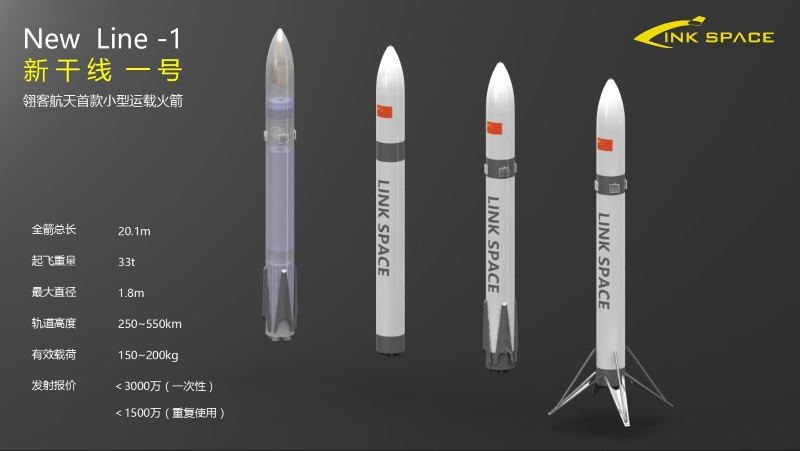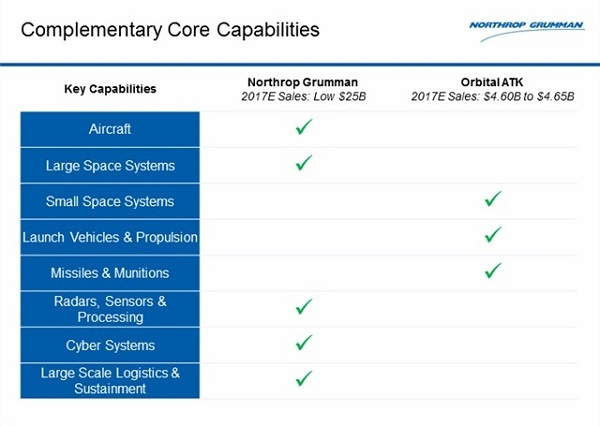The past week was marked by two in some sense complementary news. The Chinese copied the Falcon 9 SpaceX (actually not), and the company Northrop Grumman for $ 9.2 billion absorbed a large "space private" »Orbital ATK.
 Test bench test LinkSpace
Test bench test LinkSpaceNot a copy
"The Chinese copied SpaceX" - in this format you could already hear this news, it was sold very widely. But the reality is markedly different. The Chinese company LinkSpace, which is called "China's first private space company," showed the concept of the New Line 1 rocket, where the landing "legs" are easily recognizable and, if you look closely, the Spacex first-stage trellis steering wheels of the SpaceX company.
 Slide Presentation LinkSpace
Slide Presentation LinkSpaceFirst of all, the New Line 1 is much smaller and lighter than the Falcon 9. With a starting weight of 33 tons, which is 16 times lighter than the F9, the New Line 1 belongs to the launch vehicles of the ultralight class and will have to bring only 200 kg of payload to the sun-synchronous orbit . Also on the first stage there are 4 engines (instead of 9 for F9) with a load of 10 tons each (seven times weaker than the Merlin 1D). The difference in the number of engines means other landing algorithms, because you have to keep at least two engines (instead of one for F9), and from the difference in their thrust and empty mass levels it is logical to assume that Chinese engines can be throttled much more (their control can be controlled in a larger range).
Further, the specific appearance of the landing pillars does not apply to high technologies, and their copying is more a matter of appearance and design than a serious engineering task. And the lattice steering wheels were “copied” by the Falcon 9 in exactly the same sense that SpaceX itself “copied” them from the USSR, where they were invented many years ago. No specific technical solution Falcon 9 can not be directly copied to the New Line 1 - each unit will have to design a much lighter rocket from scratch.
At the same time, one thing LinkSpace still borrowed from SpaceX - the concept of landing the first stage with the help of engines on the landing pillars. The fact is that there are many options for rescuing waste stages -
engines, parachutes, wings , you can save the entire stage or just
the engine block without tanks . Each option has its pros and cons, and SpaceX has advanced the furthest in one particular way, demonstrating its fundamental feasibility. Economic calculations
need to be confirmed by long-term operation, and the reusable scheme may well have different efficiencies for launch vehicles of different weight categories. Therefore, it is more correct to say that Chinese LinkSpace was more likely inspired by SpaceX. This interview does not hide the representatives of the company:
SpaceX is very cool, and the Falcon 9 is a great rocket, we see them as a goal and an example to follow, because they have so much that we can learn
Hu Zhenyu, Founder and CEO of LinkSpace
In general, this story is suggestive, and very far from the stamps "China only copies someone else." First of all, it’s great that new space start-ups appear in different countries, it’s interesting to watch how they experiment with different technical ideas, and the likelihood is that the result will be something useful for all of humanity.
The second thought, alas, has a bitter hue. Chinese television has made a report about the company, which states that LinkSpace is six young people no older than thirty.
The startup developed its engine, made and
successfully tested several technical demonstrators that were hanging on a jet propulsion. Against this background, the results of domestic private traders look pale, and today, at best, they were able to
successfully test only the engine, and not at best, the tests ended in an
explosion and an impressive scandal . China is the first economy and the "forge" of the planet, and it already gives a systemic effect when it is much easier to engage in the production of high-tech there than in other countries. Even if New Line 1 was a complete copy, in twenty years it is not a shame to copy the best world samples. And in 10-20 years, I am afraid, we will already be copying advanced solutions from the accumulated experience of Chinese engineers.
Came to success
The second news caused less attention, but in its own way it is important and also thought-provoking. The company Notrhrop Grumman for 9.2 billion dollars acquired a private space company Orbital ATK. The question “why” is best answered by a slide from the presentation from the event dedicated to the event.
 Source: Doug Messier
Source: Doug MessierThe Orbital ATK company produces solid rocket engines that are used both for military and civilian purposes, operates Pegasus, the only air launch vehicle currently in use, and also carries cargo to the ISS on the Cygnus vehicle and Antares launch vehicle as part of the program COTS parallel to SpaceX. They also exploit the Minotaur booster rocket and built the Dawn probe on NASA’s order, which is now investigating Ceres. Northrop Grumman is a relatively old and very large company (assets valued at $ 25 billion for 2016), which operates in the aerospace and military industries. In addition to, for example, B-2 bombers or TDRSS communication satellites, Northrop Grumman is the main contractor in the creation of the James Webb telescope.
 Antares RN, photo by Ken Kremer
Antares RN, photo by Ken KremerCompanies really complemented each other quite well, and it would be worthwhile to be upset about their merger, except for military customers only -
there will be less competition and prices may rise. In the space sphere, a curious picture is obtained - Northrop Grumman is just as private as Orbital ATK, but the language is not turning here. The concept of “private space exploration” now has a distinct spirit of start-ups, new and, at least initially, small companies. But those firms that are fortunate enough to grow and “come to success” are changing and integrating into the system at a new level. At the same time, by the way, the company's external attractiveness is lost. This is normal, for example, Google already few people call a "corporation of good." And if, like in the first news, imagine the future in 10-20 years, then this effect can give funny results - the success of the same SpaceX can generate news like “Boeing, Lockheed Martin, Northrop Grumman and SpaceX created the
American Launch Alliance company, Experts fear rising prices for space launches under monopoly conditions. ”
In general, though in some places with a bitter taste, both news is good. Whether new companies are emerging or old companies are growing up, this indicates an active life in the space industry.